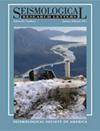Induced Seismicity Forecasting with Uncertainty Quantification: Application to the Groningen Gas Field
IF 3.2
3区 地球科学
Q2 GEOCHEMISTRY & GEOPHYSICS
引用次数: 1
Abstract
Reservoir operations for gas extraction, fluid disposal, carbon dioxide storage, or geothermal energy production are capable of inducing seismicity. Modeling tools exist for seismicity forecasting using operational data, but the computational costs and uncertainty quantification (UQ) pose challenges. We address this issue in the context of seismicity induced by gas production from the Groningen gas field using an integrated modeling framework, which combines reservoir modeling, geomechanical modeling, and stress-based earthquake forecasting. The framework is computationally efficient thanks to a 2D finite-element reservoir model, which assumes vertical flow equilibrium, and the use of semianalytical solutions to calculate poroelastic stress changes and predict seismicity rate. The earthquake nucleation model is based on rate-and-state friction and allows for an initial strength excess so that the faults are not assumed initially critically stressed. We estimate uncertainties in the predicted number of earthquakes and magnitudes. To reduce the computational costs, we assume that the stress model is true, but our UQ algorithm is general enough that the uncertainties in reservoir and stress models could be incorporated. We explore how the selection of either a Poisson or a Gaussian likelihood influences the forecast. We also use a synthetic catalog to estimate the improved forecasting performance that would have resulted from a better seismicity detection threshold. Finally, we use tapered and nontapered Gutenberg–Richter distributions to evaluate the most probable maximum magnitude over time and account for uncertainties in its estimation. Although we did not formally account for uncertainties in the stress model, we tested several alternative stress models, and found negligible impact on the predicted temporal evolution of seismicity and forecast uncertainties. Our study shows that the proposed approach yields realistic estimates of the uncertainties of temporal seismicity and is applicable for operational forecasting or induced seismicity monitoring. It can also be used in probabilistic traffic light systems.诱发地震预测与不确定性量化:格罗宁根气田的应用
天然气开采、流体处理、二氧化碳封存或地热能源生产等储层作业都可能诱发地震。目前已有利用作业数据进行地震预测的建模工具,但计算成本和不确定性量化 (UQ) 带来了挑战。我们利用综合建模框架,结合储层建模、地质力学建模和基于应力的地震预报,以格罗宁根气田的天然气生产诱发的地震为背景,解决了这一问题。由于采用了二维有限元储层模型(假定垂直流动平衡),并使用半解析解计算孔弹性应力变化和预测地震率,因此该框架的计算效率很高。地震成核模型基于速率与状态摩擦,允许初始强度过剩,因此不假定断层最初处于临界应力状态。我们估计了预测地震次数和震级的不确定性。为了降低计算成本,我们假设应力模型是真实的,但我们的 UQ 算法具有足够的通用性,可以将储层和应力模型的不确定性纳入其中。我们探讨了选择泊松概率或高斯概率对预测的影响。我们还使用合成目录来估算地震探测阈值的提高对预报性能的影响。最后,我们使用锥形和非锥形古腾堡-里克特分布来评估随时间变化的最可能最大震级,并考虑其估算中的不确定性。虽然我们没有正式考虑应力模型中的不确定性,但我们测试了几种可供选择的应力模型,发现它们对预测的地震时间演变和预报不确定性的影响微乎其微。我们的研究表明,所提出的方法能对时间地震的不确定性做出切合实际的估计,适用于业务预报或诱发地震监测。它还可用于概率交通灯系统。
本文章由计算机程序翻译,如有差异,请以英文原文为准。
求助全文
约1分钟内获得全文
求助全文
来源期刊

Seismological Research Letters
地学-地球化学与地球物理
CiteScore
6.60
自引率
12.10%
发文量
239
审稿时长
3 months
期刊介绍:
Information not localized
 求助内容:
求助内容: 应助结果提醒方式:
应助结果提醒方式:


